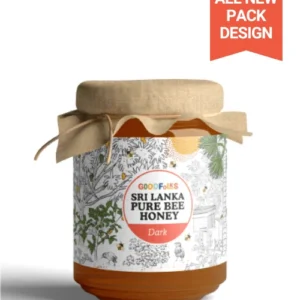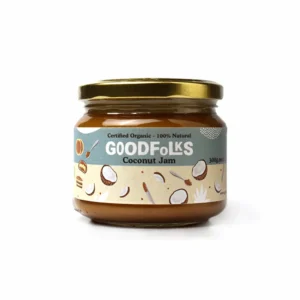Description
Organic Sri Lankan Nutmeg – Ceylon Nutmeg
Initially introduced to the island by ancient Arab traders around the 9th century, nutmeg has flourished in Sri Lanka’s lush, tropical climate. This environment has imbued Ceylon Nutmeg with a distinctive flavor and aroma, setting it apart from nutmegs grown in other regions. The term “Ceylon Nutmeg” pays homage to the island’s former name, Ceylon, and is now synonymous with this exceptional spice.
With Goodfolks you can opt to source Sri Lankan Nutmeg (Ceylon Nutmeg) with Organic Certification. Alternatively, you can choose to have it procured from the thriving network of Home Gardens and small-scale farms through our Regenerative Agriculture program. This ensures not only the highest quality but also supports local communities engaged in sustainable agricultural practices. By selecting our Sri Lankan Nutmeg, you are not only adding a burst of unique flavor to your dishes but also contributing to the preservation of a centuries-old tradition of spice cultivation in Sri Lanka.
The Arrival of Nutmeg to Sri Lanka
Nutmeg, like most other spices, was introduced to Sri Lanka in the 9th century by Arab traders. Recognizing the fertile soil and favorable tropical climate of Sri Lanka, they saw the potential for nutmeg cultivation to thrive in this lush environment.
The nutmeg tree, scientifically known as ‘Myristica fragrans’, found a hospitable home in the island’s central regions, where conditions proved ideal for its growth. Over time, the nutmeg trees flourished, and Sri Lanka became a significant hub for nutmeg production. The combination of nutrient-rich soil, consistent temperatures, and balanced rainfall in the central highlands created an optimal setting for cultivating high-quality nutmeg.
As generations passed, Sri Lankan farmers refined their techniques, honing their expertise in nutmeg cultivation. This rich heritage of knowledge and tradition has been handed down through the ages, ensuring that Sri Lankan nutmeg continues to be renowned for its exceptional quality and distinctive flavor profile. Today, Sri Lankan nutmeg stands as a testament to centuries of dedication and craftsmanship, making it a sought-after spice in kitchens around the world.
Unique Qualities of Sri Lankan Nutmeg
Terroir Excellence: The nutrient-rich earth in Sri Lanka’s central regions provides an optimal foundation for nutmeg trees to thrive and produce high-quality nuts. Meanwhile the island’s warm, tropical climate imparts a unique character to the nutmeg, resulting in a flavor profile that is both vibrant and distinctive.
Handcrafted Expertise: Sri Lankan nutmeg production benefits from centuries-old techniques, passed down through generations that give them an almost artisinal quality. This craftsmanship ensures meticulous care in every step of cultivation and processing. Each nutmeg is handpicked at just the right moment of ripeness, ensuring maximum flavor and aroma. Also. the nuts are processed with great care, preserving their essential oils and aromatic compounds.
Altitude Advantage & Rainfall: Nutmeg trees in Sri Lanka often thrive at higher elevations. This unique setting results in a slower growth process, allowing for the development of more complex and nuanced flavors. Additionally, Sri Lanka’s diverse micro-climates, particularly in the central highlands, strike a delicate balance between providing sufficient moisture for nutmeg trees without risking water-logging.
Grades of Sri Lankan Nutmeg
Whole Nutmeg: This is the intact nutmeg seed that hasn’t been broken or ground. It is considered the highest grade and is often used for grating or grinding fresh for culinary applications.
Ground Nutmeg: This is nutmeg that has been dried and ground into a fine powder. It is convenient for use in recipes and is commonly found in grocery stores.
Grading Factors:
- Appearance: The visual quality, including color, size, and uniformity.
- Aroma: The fragrance of the nutmeg, which should be rich and characteristic of high-quality spice.
- Oil Content: The percentage of essential oils in the spice, as this affects its flavor and aroma.
- Flavour: The taste profile, which should be balanced, aromatic, and free from off-flavors.
- Purity: The absence of foreign matter or contaminants.
- Processing: The care taken in harvesting, drying, and processing the spice.
How to use Sri Lankan Nutmeg
Culinary Uses:
- Flavouring Dishes: Ground nutmeg is a versatile spice used to flavor a wide range of dishes. It’s commonly used in both sweet and savoury recipes.
- Baking: Nutmeg is a popular spice in baking, used in recipes for cakes, cookies, pies, and pastries. It pairs well with fruits like apples and pears.
- Sauces and Soups: It’s used in creamy sauces, soups, and stews to add depth of flavor.
- Beverages: Nutmeg is a common ingredient in beverages like eggnog, mulled wine, and various spiced cocktails.
- Desserts: It’s used in puddings, custards, and other desserts for its warm, nutty flavor.
Medicinal Uses:
- Digestive Aid: Nutmeg has been used traditionally as a digestive aid. It is believed to help alleviate digestive issues like bloating and gas.
- Anti-inflammatory: Nutmeg contains compounds that may have anti-inflammatory properties, and it has been used in traditional medicine for this purpose.
- Sleep Aid: In some cultures, nutmeg is used as a natural remedy to promote sleep. However, it’s important to note that excessive consumption can be harmful.
- Pain Relief: Nutmeg oil, derived from the seeds, has been used topically for pain relief in certain traditional practices.
Aromatherapy and Perfumery:
- Essential Oil: Nutmeg oil, extracted from the seeds, is used in aromatherapy for its calming and soothing properties. It’s also used in perfumery for its warm and spicy fragrance.
Traditional and Folk Remedies:
- In various traditional medicine systems, nutmeg has been used for a range of purposes, including as an aphrodisiac, to treat coughs, and as a tonic.
Industrial Uses:
- Nutmeg oil is used in the cosmetic and pharmaceutical industries as a flavouring agent and fragrance component.
Cultural and Ritual Uses:
- In some cultures, nutmeg has ceremonial or ritualistic significance and may be used in traditional practices.
Is Nutmeg and Mace the same?
Nutmeg and mace are not the same, but they come from the same fruit, which is the nutmeg tree (Myristica fragrans). Here’s how they differ:
Nutmeg:
- Nutmeg is the seed of the nutmeg tree and is roughly the size of an apricot pit. It is dark brown and has a wrinkled appearance.
- It has a warm, nutty flavor with hints of sweetness and spiciness. It is commonly used as a spice in both sweet and savoury dishes.
- Nutmeg is usually grated or ground before use to release its flavor.
Mace (See Separate Product Page):
- Mace is the outer covering, or aril, of the nutmeg seed. It is bright red when harvested and dries to a yellowish-brown colour.
- It has a unique, warm flavor similar to nutmeg but with slightly more pungency. It is often described as more delicate and subtle than nutmeg.
- Mace is used in a variety of dishes, including desserts, sauces, and soups. It can be used either whole or ground.























